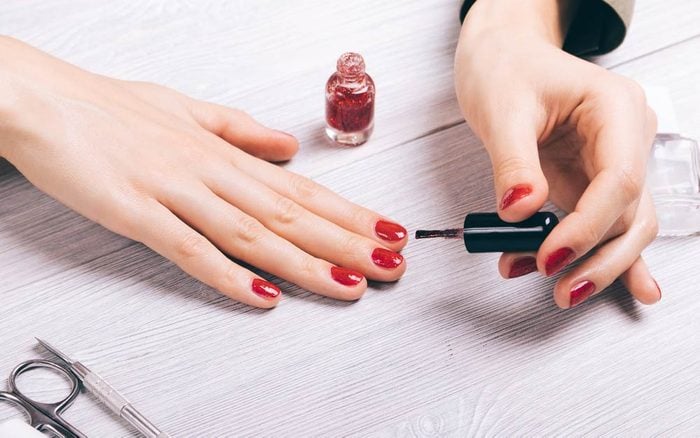The Scary Thing Nail Polish Does to Your Body 10 Hours After You Apply It
Updated: Aug. 24, 2019

This is bad news for all you devoted mani-pedi lovers out there.
Think about it: Do you know what exactly goes into making your favorite nail polish colors? (Here’s what each nail polish color reveals about you.) If you’ve never taken a close look at the ingredients in your nail polish, you might want to start now. Some of them can pose a significant hazard to your health.
A study co-authored by researchers at Duke University and the Environmental Working Group found an endocrine disrupting chemical in nail polish was detected in the bodies of every woman who volunteered to paint her nails for the study. The compound called triphenyl phosphate (TPHP) is used in plastics manufacturing as a fire retardant in foam furniture appears to be absorbed into the body via nail polish. (Some studies use the acronym TPP for this chemical.)
Researchers tested the urine samples of participants both before and after their manicures. (Technically, the researchers tested the women’s urine for a chemical biomarker called diphenyl phosphate or DPHP, which is created when the body metabolizes TPHP.) Within 10 to 14 hours of getting their nails painted, the participants’ DPHP levels were seven times higher than they were before the experiment, on average. The levels continued to rise until they reached a peak about 20 hours later, the study found. Sounds scary, right?
“Five-free” isn’t necessarily safer
“There are a few troubling findings in this report,” says Nneka Leiba, vice president of healthy living science for the Environmental Working Group (EWG). “Most nail polishes now say that they’re ‘three-free’ or ‘five-free’ and one of the chemicals that they’re free of is phthalates. Instead many of these formulas have replaced phthalates with TPHP. It’s something we call a ‘regrettable substitution.'” The concern, Leiba explains, is that both chemicals are suspected endocrine disruptors that can impact hormonal functioning.
Another consideration, Leiba says, is that we should give more scrutiny to the ingredients labels of our beauty products. “The EWG’s advice is always to be educated about the products we bring into our homes and not have any false assumptions that just because they are on store shelves that they have met rigorous levels of safety testing,” she says. “Frequently in personal care products including nail polish, there can be ingredients of concern and reading the labels and becoming educated is important.”
Leiba suggests consulting the EWG’s Skin Deep database to search for products and ingredients of concern and learn their level of toxicity and safety.
Pick your polish wisely
“Most people think that nail polish isn’t absorbed since you’re not rubbing it on your skin directly,” Leiba says. “Some of these nail polishes have solvents and other substances that increase the absorption and the contact with the cuticles can draw chemicals into the body.”
The effects of short-term exposure to the chemicals found in nail polish are still unclear, experts say. But Leiba says you don’t have to swear off manicures for good. “I look at how can I reduce the number of harmful chemicals that I am exposing myself to overall,” she says. “One way is to choose safer products whee possible and another is to reduce the frequency of the amount of manicures and pedicures.” Or you can ditch the polish altogether and try these simple ways to make your nails stronger.
If you’ve sworn off nail polish for now, we have some brilliant uses for that extra polish sitting in your drawer.